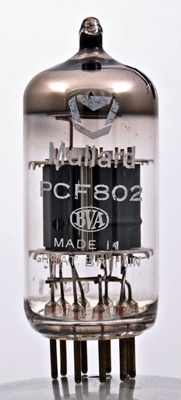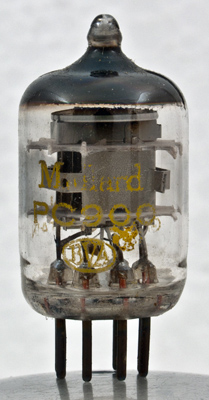|
Two New Mullard Television Valves
 
Mullard PCF802 and PC900.
PCF802
PCF802 - A triode pentode for line oscillators.
With the coming of a negative-modulation 625 line television service in this country, receivers have been produced using line oscillators operating on the flywheel principle. In anticipation of this, Mullard have recently introduced a new triode pentode - the PCF802 - which has been developed specifically for this application.
In a typical mode of operation, the pentode section of the PCF802 will be used as a Class C sine wave oscillator whose frequency is controlled by the triode section of the valve functioning as a reactance valve. The DC frequency control signal at the triode grid is obtained in a phase-frequency detector comparing the incoming synchronising pulses with pulses taken from the line output stage.
Any interference in either the pentode or triode circuits manifests itself as a disturbance in the horizontal direction of the lines on the screen, the permissible limits (peak-to-peak on the screen of a 23-inch picture tube) being - displacement due to microphony 1 mm, displacement due to hum 0.2 mm and displacement due to insulation faults 0.5 mm.
An attractive feature of this circuit is that only one switch is needed to change the frequency of the oscillator from that required for the 405 line standard 10.125kHz - to that required for the 625 line standard 15.625kHz.
Special attention has been paid in the the development of the new valve to minimising hum and microphonic interference, which can be troublesome in this type of line-oscillator circuit. Furthermore, the amplification factor of the triode section of the valve is high, thus making the section particularly suitable for operation as a reactance valve.
Micrphony
A rigid structure is essential, and the following precautions are taken in the design of the PCF802:
- A mica spacer at the top with fingers pressing down on the cathodes of the two tube sections
- Negative play in the top and bottom spacers for the first and second grid backbones of the pentode section, and for the grid backbones of the triode section
- Negative play in the top and bottom spacers for the anode lugs of the triode section.
These measures ensure that the microphony level is at least a factor of five smaller than the permissible limit.
Hum
Grid hum depends on two capacitances: the grid-to-heater capacitance in the triode section; and the first-grid-to-heater capacitance in the pentode section. Cathode hum arises as a result of cathode-to-heater capacitance and cathode-to-heater insulation conductance, the most critical factor being the latter. The structure of the PCF802 is designed to minimise these factors, and to prevent grid hum from increasing during life due to deposits in the tube. Cathode hum tends to decrease during life because the cathode-to-heater insulation improves with life.
Insulation Faults
Two important measures taken during manufacture prevent insulation faults:
- A slot is provided in the mica spacers between the anode lugs and the grid backbones of the triode section;
- The double top and bottom spacers, which havenegative play, for the grid backbones andcathode are of the labyrinth type.
Mullard tests on the PC F802 revealed no insulation faults in either section in 3,000 hours of operation. The precautions described make the PCF802 eminently suitable for use as a line oscillator valve. ln designing television line oscillators it is usual to ensure that the cathode-to-heater voltage and cathode impedance of the triode section are minimised and the cathode impedance is decoupled for 50 Hz. Provided these design points are observed with circuits using the PCF802, the safeguards described ensure that no rejects due to microphony, hum or insulation faults are likely to occur.
PC900
PC900 - An RF triode for VHF television tuners In many television receivers, the circuitry of the VHF tuner is now simplified by the use of a new RF valve - the Mullard frame-grid triode, type PC900.
The PC900, which is an improved version of the PC97, has been designed for use as a single triode RF amplifier. In such a stage, it gives a noise factor which is of the same order as that of double-triode cascode stages. The new valve possesses a very low value of anode to grid capacitance (0.35pF). Consequently neutralisation is easier than with earlier RF valves. The values of mutual conductance (14.5mA/V) and input impedance of the valve are high, and the input capacitance (0.080pF) is very low. As a result, the gain of a single triode stage using the PC900 is about twice that to be obtained with previously recommended RF triodes. Use of the PC900 in television VHF tuners thus offers greater simplicity in the circuitry and a higher level of performance than hitherto attainable.
|